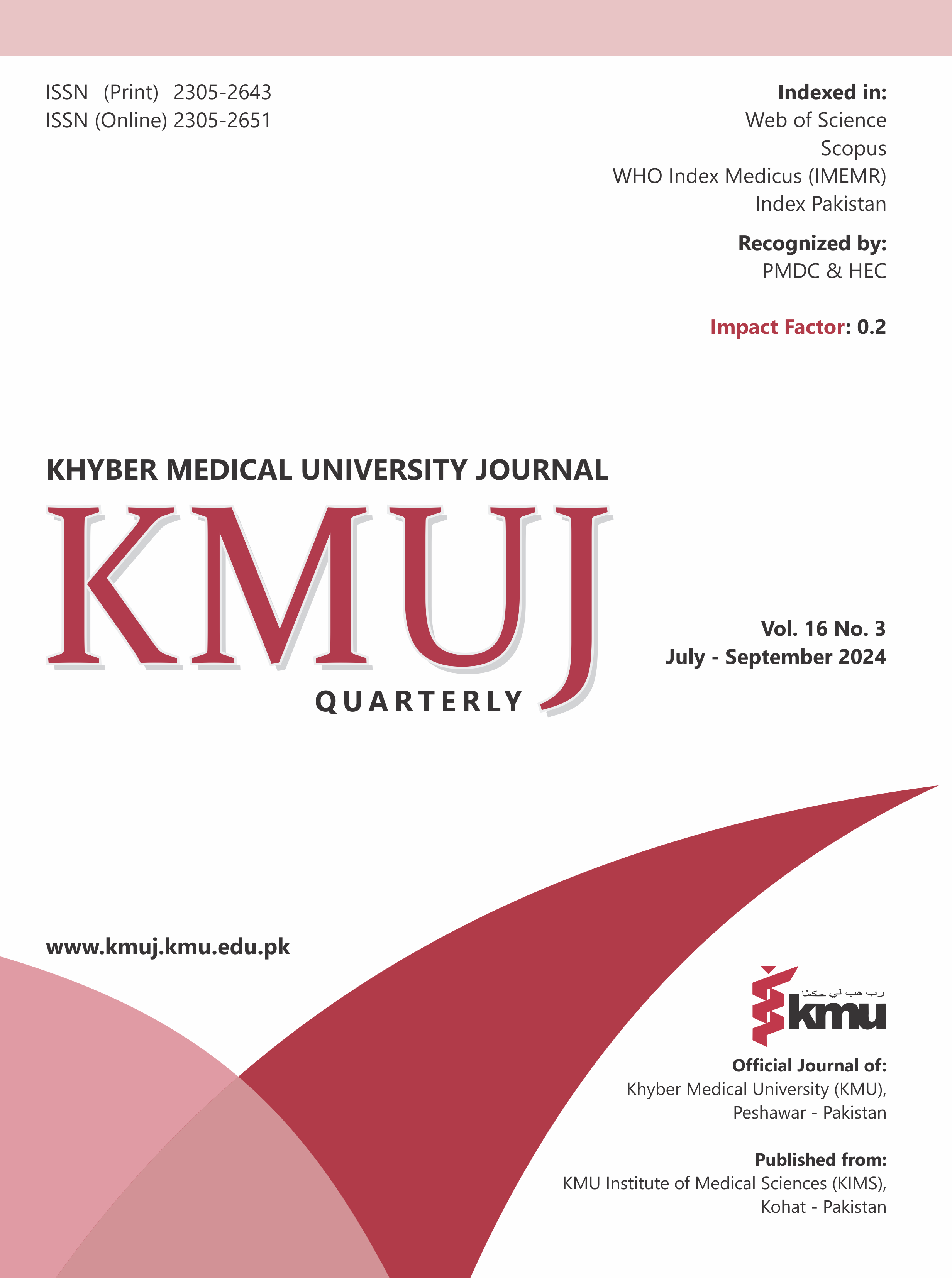Caffeine consumption and voice health of university teachers: a safe bet!
Main Article Content
Abstract
OBJECTIVE: To determine the effects of caffeine on the vocal health of university teachers.
METHODS: This cross-sectional study employed a non-probability convenience sampling technique to recruit 362 university teachers from Riphah International University, University of Education, University of Management and Technology, and University of Punjab, Pakistan between January 1, 2022, and June 31, 2022. The sample included both male and female participants aged 25 to 60 years. A Basic Demographic Sheet and the Voice Handicap Index (VHI) were used for data collection. Data were analyzed using SPSS version-22.
RESULTS: Out of 362 university teachers, 239 (66%) were females and majority (n=92/362, 25.4%) were within the 30-35 years’ age group. The majority of university teachers (n=290; 80.11%) in the study were caffeine users. Among them, 196 (54.1%) had severe voice handicaps, with 72 (19.9%) being non-caffeine users. Importantly, all teachers with mild and moderate handicaps were caffeine users (p=0.000). VHI scale, including functional, physical, and emotional subscale scores, as well as total mean scores, were significantly higher among non-caffeine users (p<0.001). Caffeine use was reported by 91.87% of males, compared to 74.06% of females (p<0.001). Additionally, significantly more males and individuals aged 25-40 years were found to be caffeine users (p<0.05). Both gender and age showed a significant correlation with VHI scores (p<0.001).
CONCLUSION: Caffeine consumption does not significantly impact voice handicaps in the Pakistani context. However, gender and age demonstrate a significant correlation with voice handicaps, indicating that these demographic factors play a more crucial role in influencing vocal health.
Article Details

This work is licensed under a Creative Commons Attribution 4.0 International License.
Work published in KMUJ is licensed under a
Creative Commons Attribution 4.0 License
Authors are permitted and encouraged to post their work online (e.g., in institutional repositories or on their website) prior to and during the submission process, as it can lead to productive exchanges, as well as earlier and greater citation of published work.
(e.g., in institutional repositories or on their website) prior to and during the submission process, as it can lead to productive exchanges, as well as earlier and greater citation of published work.
References
1. Rodak K, Kokot I, Kratz EM. Caffeine as a factor influencing the functioning of the human body-friend or foe? Nutrients 2021;13(9):3088. https://doi.org/10.3390/nu13093088
2. Bdullahi R, Lawal A, Ibrahim M, Khalid A, Muhammad U. Assessment of the level of caffeine in some tea leaves marketed in dutse: Jigawa state. Korean J Food Health Converg 2019;5(3):7-20. https://doi.org/10.13106/kjfhc.2019.vol5.no3.7
3. Knapik JJ, Steelman RA, Trone DW, Farina EK, Lieberman HR. Prevalence of caffeine consumers, daily caffeine consumption, and factors associated with caffeine use among active duty United States military personnel. Nutr J 2022;21(1):22. https://doi.org/10.1186/s12937-022-00774-0
4. Azari S, Aghaz A, Maarefvand M, Ghelichi L, Pashazadeh F, Shavaki YA. The prevalence of voice disorders and the related factors in university professors: a systematic review and meta-analysis. J Voice 2022:S0892-1997(22)00057-1. https://doi.org/10.1016/j.jvoice.2022.02.017
5. Franca MC, Simpson KO, Schuette A. Effects of caffeine on vocal acoustic and aerodynamic measures of adult females. CoDAS 2013;25(3):250-5. https://doi.org/10.1590/s2317-17822013000300010
6. Kahlenberg RD, Potter H. Why teacher voice matters. American Educator. Winter 2014-15. [Accessed on: July 10, 2023]. Available from URL:https://www.aft.org/sites/default/files/kahlenberg.pdf
7. Mahmoud NF, Khaled DMF. Mohammed HO. Knowledge of Egyptian faculty members about voice care: a national cross-sectional study. Egypt J Otolaryngol 2022;38:59. https://doi.org/10.1186/s43163-022-00247-5
8. Kyriakou K, Petinou K, Phinikettos I. Risk factors for voice disorders in university professors in cyprus. J Voice 2018;32(5): 643.e1-643.e9. https://doi.org/10.1016/j.jvoice.2017.07.005
9. Georgalas VL, Kalantzi N, Harpur I, Kenny C. The effects of caffeine on voice: a systematic review. J. Voice. 2023;37(4):636.e7-636.e19. https://doi.org/10.1016/j.jvoice.2021.02.025
10. Bolbol SA, Zalat MM, Hammam RA, Elnakeb NL. Risk factors of voice disorders and impact of vocal hygiene awareness program among teachers in public schools in Egypt. J Voice 2017;31(2):251e.9-251e.16. https://doi.org/10.1016/j.jvoice.2016.07.010
11. Johnson AF, Jacobson B, Grywalski C, Silbergleit A, Jacobson G, Benninger MS. The Voice Handicap Index (VHI). Am J Speech Lang Pathol 1997;6(3):66-70. https://doi.org/10.1044/1058-0360.0603.66
12. Grandjean AC, Reimers KJ, Bannick KE, Haven MC. The effect of caffeinated, non-caffeinated, caloric and non-caloric beverages on hydration. J Am Coll Nutr 2000;19(5):591-600. https://doi.org/10.1080/07315724.2000.10718956.
13. Nehlig A. Interindividual differences in caffeine metabolism and factors driving caffeine consumption. Pharmacological Rev 2018;70(2):384-411. https://doi.org/10.1124/pr.117.014407
14. Byeon H. The risk factors related to voice disorder in teachers: a systematic review and meta-analysis. Int J Environ Res Public Health 2019;16(19):3675. https://doi.org/10.3390/ijerph16193675.
15. Akhtar S, Wood G, Rubin JS, O'Flynn PE, Ratcliffe P. Effect of caffeine on the vocal folds: A pilot study. J Laryngol Otol 1999;113(4):341-5. https://doi.org/10.1017/s0022215100143920
16. Akinbode R, Lam KBH, Ayres JG, Sadhra S. Voice disorders in Nigerian primary school Teachers. Occup Med 2014;64:382–386. https://doi.org/10.1093/occmed/kqu052
17. Levendoski EE, Sivasankar S. Investigating the effects of caffeine on phonation. J Voice 2011;25(5):215-9. https://doi.org/10.1016/j.jvoice.2011.02.009
18. Ahmed EE, Bukhari MA, Melibary RA. Voice disorders among academic staff at king saud university medical college (comparison between basic science and clinical staff). J Otolaryngol ENT Res 2017;8(1):394‒6. https://doi.org/10.15406/joentr.2017.08.00233
19. Moy FM, Hoe VCW, Hairi NN, Chu AHY, Bulgiba A, Koh D. Determinants and effects of voice disorders among secondary school teachers in Peninsular Malaysia using a validated malay version of VHI-10. PLoS One 2015;10(11):e0141963. https://doi.org/10.1371/journal.pone.0141963
20. Dillon P, Kelpin S, Kendler K, Thacker L, Dick D, Svikis D. Gender differences in any-source caffeine and energy drink use and associated adverse health behaviors. J Caffeine Adenosine Res 2019;9(1):12–19. https://doi.org/10.1089/caff.2018.0008
21. Alarouj H, Althekerallah JM, AlAli H, Ebrahim MA. A comparative study utilizing the Voice Handicap Index-10 (VHI-10) in teachers and the general population of Kuwait. J Voice 2022;36(2):289.e1-299.e10. https://doi.org/10.1016/j.jvoice.2020.05.006
22. Flynn H. Can adding milk to a cup of coffee have anti-inflammatory effects? Medical News. [Accessed on: July 3, 2023]. Available from URL: https://www.medicalnewstoday.com/articles/can-adding-milk-to-a-cup-of-coffee-have-anti-inflammatory-effects
